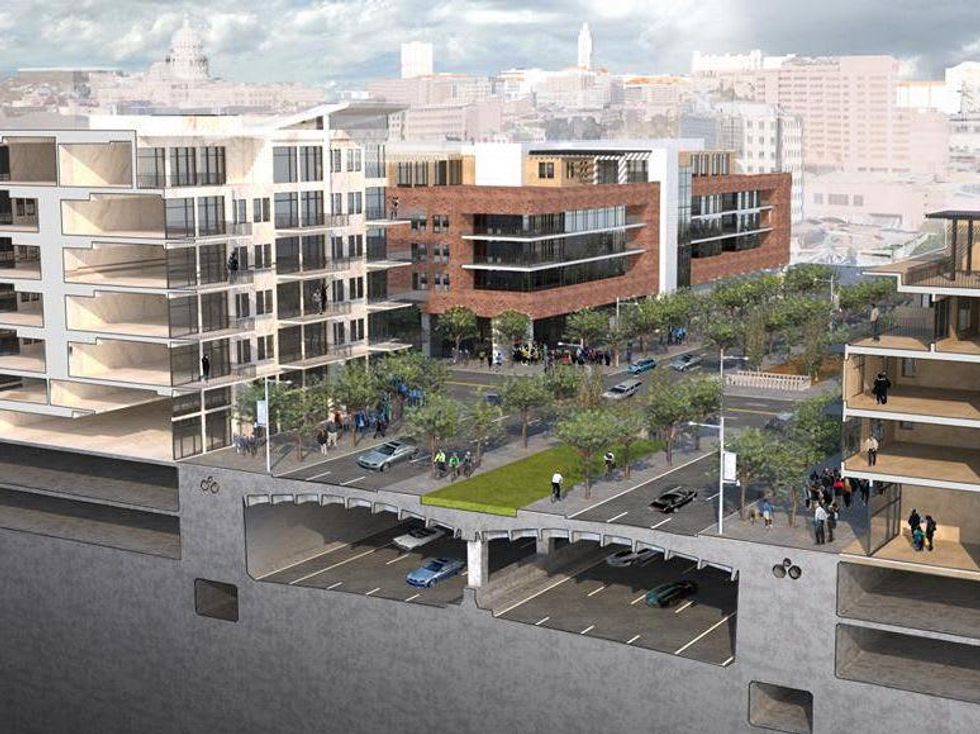Downtown Park Envy
Radical Austin proposal to sink I-35 resembles Klyde Warren Park on steroids
As anyone who’s been to Austin on a Friday afternoon knows, Interstate 35 is a miserable necessity that can turn the entire city into a glorified parking lot. It's been so bad that for the past two years, the Texas Department of Transportation has been looking for ways to relieve the fourth-worst traffic in America.
Longtime University of Texas School of Architecture professor Sinclair Black thinks that the solution to clearing the city’s largest artery lies underground.
In a project dubbed Reconnect Austin, Black and his associates argue that sinking a one-mile stretch of I-35 in downtown Austin would relieve the notoriously bad traffic, reunite the two halves of Austin currently split by the highway, and create new revenue-generating land.
On its website, Reconnect Austin cites the success of Klyde Warren as one of several instances in which a sunken highway has benefited a city.
Reconnect Austin calls the interstate a “social, economic, cultural and racial barrier, dividing West Austin from East Austin.” By sinking the mile of highway, the plan allows for 30 acres of downtown real estate to be developed as well as linking together streets on both sides to create a more free-flowing Austin. The plan also calls for adding a lane to I-35 in both directions.
Reconnect Austin's project manager, Heyden Walker, from Black's firm, Black + Vernooy, says that Black originally came up with the plan to depress a stretch of I-35 back in the '90s. TxDOT even drew up a plan, but it fell apart. It was after working on the Waller Creek tunnel project last year that freed up 28 acres of downtown land from flood plains that Black decided to reintroduce the "Cut and Cap" plan.
If this sounds like Klyde Warren Park on steroids, the comparison is not incidental. On its website, Reconnect Austin cites the success of Klyde Warren as one of several instances in which a sunken highway has benefited a city. Other examples include the Big Dig in Boston and U.S. Highway 59 in Houston. Although Klyde Warren shares many traits with the Cut and Cap plan, the Dallas park extends only a fifth of a mile and covers just more than five acres.
Of course, the cost for the park was around $100 million, while the plan for I-35 would run $550 million, but Walker says that the cap part of Klyde Warren is actually where they got their number, and it's been vetted by TxDOT and their consultants. Reconnect Austin claims that the increased land development will create $3.2 billion in new tax base and more than $900 million in new tax revenue, while also creating 48,000 jobs.
Walker says the fact that TxDOT was behind Klyde Warren Park proves that this kind of project is feasible in Austin.
"It's a really important precedent, because it shows that Dallas had a vision and worked with TxDOT to make that happen," she says. "Working with neighborhood and community groups here [in Austin], we've been saying that unless we have a vision that we believe in, we're just going to get an off-the-shelf highway design, because it's easier."
On June 20, the Austin City Council endorsed the plan and approved its addition to TxDOT's National Environmental Policy Act study as well as an economic analysis of the plan. TxDOT is evaluating all proposals for renovations on I-35 as the agency hosts open houses in Austin and online this week.
Walker says that the timetable is still in years rather than months, as TxDOT is only in phase two of five, with the environmental analysis and federal government involvement still to come.




